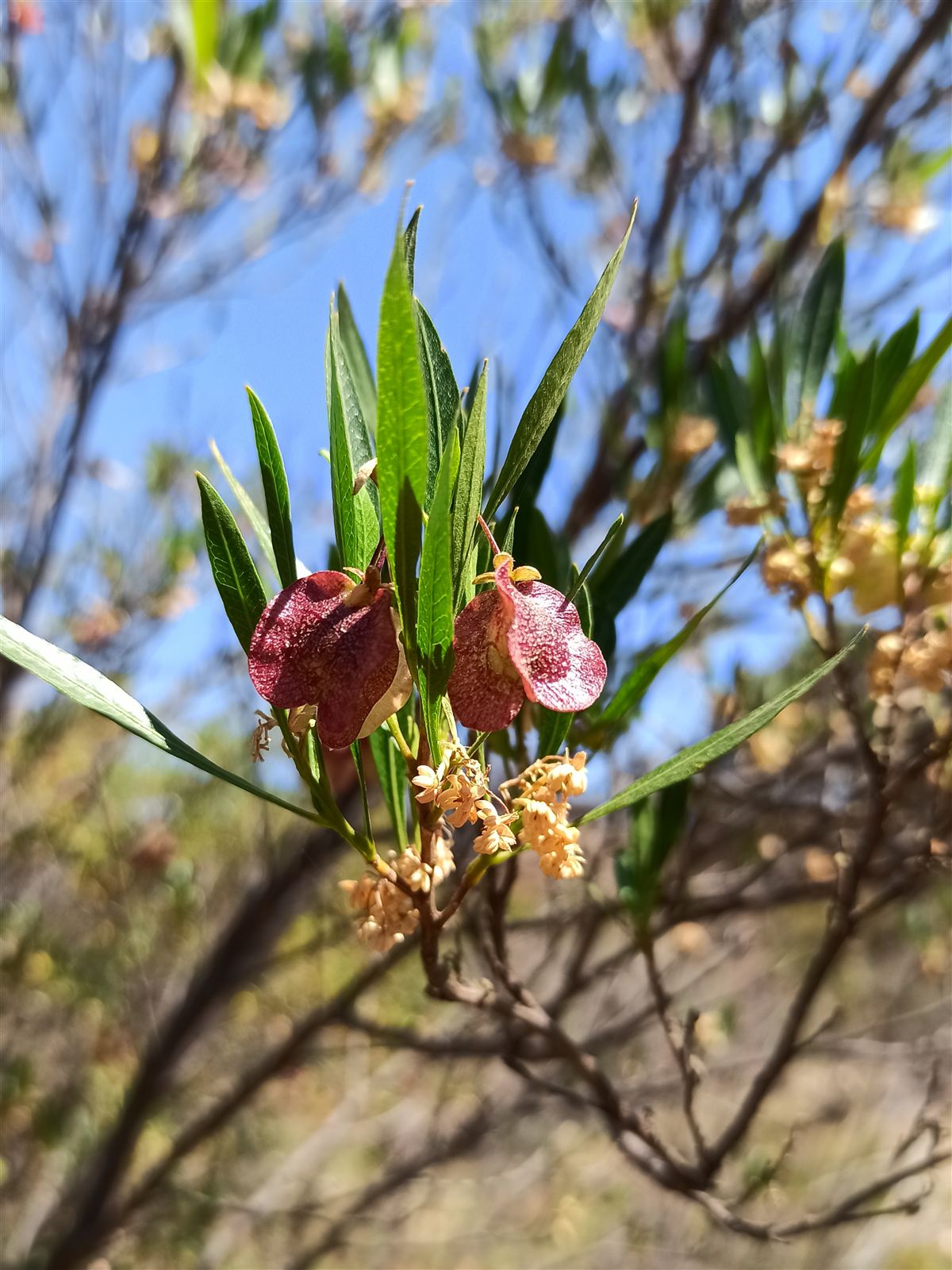Akeake (Dodonaea viscosa)
Dodonaea viscosa
Dodonaea viscosa, commonly known as Akeake or Hopbush, is a hardy and versatile native shrub or small tree. Valued for its tough nature and attractive foliage, particularly in its purple-leaved forms, this fast-growing species excels in coastal conditions and challenging sites. Its distinctive winged seed capsules and dense growth habit make it both ornamentally appealing and practically useful as a shelter or screening plant.

Image credit: Wikipedia
Quick Facts
| Height | 3-7 meters |
|---|---|
| Spread | 2-4 meters |
| Water Needs | Low to moderate |
| Light | Full sun |
| Growth Rate | Fast |
| Soil Type | Well-draining, tolerates poor soils |
| Frost Tolerance | Moderate |
Climate & Conditions
Natural Habitat
Akeake is naturally found in coastal and lowland areas throughout New Zealand, particularly in drier eastern regions. It's a pioneer species that colonizes disturbed sites, rocky areas, and forest margins.
Preferred Conditions
- Sun Exposure: Thrives in full sun but tolerates partial shade.
- Wind Tolerance: Exceptional resistance to strong winds, including salt-laden coastal winds.
- Temperature Range: Hardy to about -5°C. Young plants may need protection in hard frosts.
- Rainfall: Drought tolerant once established, though responds well to occasional deep watering during prolonged dry spells.
Adaptability
Akeake is renowned for its adaptability to challenging sites, making it ideal for coastal gardens, exposed positions, and poor soils. It's particularly valuable in areas where other plants struggle to establish.
Growing & Maintenance
General Care
- Watering: Water regularly until established, then only during prolonged drought.
- Feeding: Generally not required, though a light application of slow-release fertilizer in spring can promote vigorous growth.
- Pruning: Responds well to pruning and can be shaped as desired. Prune in late winter or early spring.
Maintenance Level
Low maintenance once established. Occasional pruning to maintain shape and remove any damaged branches is all that's typically required.
Planting
When to Plant
Autumn or spring are ideal planting times, allowing roots to establish before temperature extremes.
How to Plant
- Dig a hole twice as wide and slightly deeper than the root ball.
- Incorporate some compost into the backfill soil if planting in very poor soil.
- Position the plant at the same soil level as it was in its container.
- Backfill and firm gently, creating a slight basin for water retention.
- Water thoroughly after planting.
- Apply a 5-7cm layer of mulch, keeping it away from the trunk.
Spacing
Space plants 1-2 meters apart for a hedge or screen, or 3-4 meters apart when growing as specimen trees.
Cultural & Historical Significance
Māori Uses
Traditionally, Māori valued the extremely hard, dense wood of Akeake for making tools, weapons (particularly patu and wahaika), and other implements that required strength and durability.
Cultural Significance
The name 'Akeake' in Māori translates to 'forever and ever,' possibly referring to the durability of its timber. It was considered one of the toughest woods available.
Historical Uses
Early European settlers also recognized the value of Akeake wood and used it for tool handles, machinery parts, and other applications requiring strong, dense timber.
Landscaping Uses
Garden Design
- Screening: Excellent fast-growing hedge or screen plant.
- Coastal Gardens: Ideal for wind-exposed coastal sites.
- Color Accent: Purple-leaved forms provide distinctive foliage color.
- Small Gardens: Can be maintained as a compact shrub through regular pruning.
Companion Plants
Pairs well with other coastal-tolerant natives such as Coprosma repens, Phormium cookianum, and Apodasmia similis for a complete coastal garden scheme.
Propagation
From Seed
- Collect seed when capsules turn reddish-brown but before they open.
- Dry capsules in a paper bag to catch seeds as they release.
- Sow fresh seed in a well-draining seed-raising mix.
- Keep moist and in a warm position.
- Germination typically takes 2-4 weeks.
From Cuttings
- Take semi-hardwood cuttings in late summer or autumn.
- Dip in rooting hormone for best results.
- Place in a free-draining propagation mix.
- Keep humid but not wet until rooted, usually within 6-8 weeks.
Pests & Diseases
Common Pests
- Scale Insects: May occasionally infest stems and leaves. Control with horticultural oil if severe.
- Aphids: Can affect new growth. Usually controlled by natural predators.
Disease Prevention
- Root Rot: Avoid waterlogged soils to prevent root diseases.
- General Health: Ensuring good air circulation helps prevent fungal issues.
Akeake is generally very resistant to pests and diseases, making it a low-maintenance addition to most gardens.
Seasonal Care
Spring
- Ideal time for planting new specimens.
- Apply mulch to retain moisture as temperatures increase.
- Prune to shape if needed.
Summer
- Water during extended dry periods for the first 2-3 years.
- Monitor for any pest issues, though these are rare.
Autumn
- Another good planting time.
- Enjoy the colorful seed capsules that develop.
Winter
- Generally requires no special care.
- Protect very young plants from severe frost in colder regions.
Ecological Benefits
Wildlife Value
Provides shelter and nesting sites for small birds. The dense growth habit creates protected microhabitats for various insects and other wildlife.
Environmental Contributions
- Erosion Control: Effective for stabilizing slopes due to its fast growth and hardy nature.
- Pioneer Species: Helps establish vegetation in disturbed or challenging sites, creating conditions for other plants to follow.
- Wind Protection: Creates sheltered microclimates that benefit more sensitive plants.
Bonus Tip
Create a stunning color contrast in your garden by planting the purple-leaved form of Akeake (Dodonaea viscosa 'Purpurea') alongside plants with silver or golden foliage. Good companions include Corokia 'Frosted Chocolate', Libertia peregrinans (for its orange-toned foliage), and Astelia chathamica (for silver contrast). This combination works particularly well in coastal gardens where these hardy natives will thrive while creating year-round visual interest through foliage contrast rather than relying on seasonal flowers.



